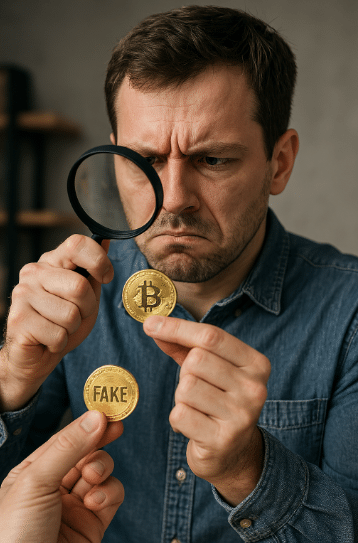“I lost everything.” These three devastating words echo across online forums as another victim falls prey to cryptocurrency fraud.
With losses exceeding $1 billion in crypto scams during just the first three quarters of 2024, the digital gold rush has created a perfect hunting ground for sophisticated predators.
The technical complexity of blockchain, combined with the promise of quick wealth, creates a dangerous environment where distinguishing legitimate innovation from elaborate fraud schemes becomes increasingly difficult.
This guide will arm you with the critical knowledge to protect your digital assets and invest with confidence in an ecosystem where a moment of carelessness can cost you everything.
Key Takeaways — Identifying Fake Cryptocurrency
- Always conduct thorough research on any cryptocurrency project, including checking team credentials, code transparency, and regulatory compliance before committing any funds.
- Fake cryptocurrencies typically exhibit common warning signs, including unrealistic promises, pressure tactics, anonymous development teams, and excessive marketing focused on price rather than technology.
- Using established exchanges, enabling multi-factor authentication, storing assets in secure wallets, and staying informed about emerging scam techniques are your best defenses against cryptocurrency fraud.
Popular Fake Cryptocurrency Scams
Cryptocurrency scams continue to evolve, becoming increasingly sophisticated as technology advances.

Understanding the most common types of fraud can help investors recognize and avoid potential traps:
1. Pump and Dump Schemes
These scams involve artificially inflating a cryptocurrency’s price through false statements and coordinated buying, followed by scammers selling their holdings once prices peak.
This tactic has become so prevalent that several high-profile personalities, including Logan Paul, Floyd Mayweather, and Kim Kardashian, have been linked to such schemes, with some facing government charges and fines for promoting cryptocurrencies without disclosing they were paid to do so.
2. Pig Butchering Scams
This particularly insidious scam combines social engineering with investment fraud. Scammers establish a relationship (social, romantic, or business-focused) with victims, gradually introducing them to fraudulent investment opportunities after gaining their confidence.
These schemes often involve creating fake exchange platforms that display artificial gains to convince victims to invest more before eventually stealing all funds.
3. Rug Pulls
In this variation of investment fraud, developers attract investors to a new cryptocurrency project through online crowdfunding, pump up the token’s value, and then disappear before the project is built, leaving investors with worthless currency.
This practice has become particularly common with meme coins and new token offerings.
How To Identify Fake Cryptocurrency Scams?
Identifying fraudulent cryptocurrency projects requires vigilance and attention to several key warning signs.

Here are the most reliable indicators that a cryptocurrency or token may be a scam:
Check For Unrealistic Promises and Returns
Be extremely cautious of any project promising guaranteed returns or abnormally high profits, especially in short timeframes. Legitimate investments always involve risk, and anyone claiming otherwise is likely attempting to deceive you.
Phrases like “risk-free investment,” “guaranteed daily returns,” or promises of doubling your money should immediately raise suspicion.
Anonymous or Unverifiable Team
Legitimate cryptocurrency projects typically have transparent development teams with verifiable backgrounds in blockchain technology, finance, or related fields. If a project’s website lacks detailed information about team members or features, stock photos, and vague biographies, consider it a major red flag.
Try searching team members’ names online—if they have no digital footprint or professional profiles on platforms like LinkedIn, proceed with extreme caution.
Poor Technical Documentation
Every cryptocurrency goes through a development process that typically includes publishing a white paper outlining the protocols, blockchain structure, and formulas that explain how the network functions.
Fraudulent projects often have poorly written white papers filled with technical jargon but lacking substance, formulas that don’t add up, or vague descriptions of revolutionary technology without technical specifics.
Excessive Marketing with Limited Substance
Legitimate blockchain projects typically focus their communications on technological development, problem-solving capabilities, and community building.
Be wary of cryptocurrencies that invest heavily in marketing campaigns featuring celebrity endorsements, flashy websites, and aggressive social media promotion but offer little technical information about the actual product.
Pressure Tactics and Urgency
Scammers often create artificial time pressure to prevent potential victims from conducting proper research. Claims about “limited-time offers,” “exclusive pre-sales ending soon,” or warnings that you’ll “miss out on massive profits” are designed to trigger emotional rather than rational decision-making.
Centralized Control and Lack of Transparency
Check whether the cryptocurrency has open-source code available for public review. Legitimate projects typically publish their code on platforms like GitHub, allowing developers to inspect and validate it.
Also, investigate how tokens are distributed—if a small number of wallets hold the majority of tokens, this suggests potential for price manipulation.
Absence of a Clear Use Case
Every legitimate cryptocurrency should solve a specific problem or serve a distinct purpose in the blockchain ecosystem. If you can’t clearly articulate a token’s practical utility beyond speculation on its price, it may be designed solely to extract money from investors.
What To Do If You Fall For a Fake Cryptocurrency Scam?
Discovering you’ve fallen victim to a cryptocurrency scam can be devastating, but taking prompt action may help minimize losses:
- Document Everything
Capture screenshots of all communications, transactions, wallet addresses, and the platform’s website or app interfaces. This documentation will be crucial for reporting the fraud.
- Contact Authorities
Report the scam to your local law enforcement, the FBI’s Internet Crime Complaint Center (IC3), the Commodity Futures Trading Commission (CFTC), and the Securities and Exchange Commission (SEC). The sooner you report, the better chance authorities have of tracing the funds.
- Alert Your Exchange
If you purchased the cryptocurrency through a legitimate exchange, contact their support team immediately. While cryptocurrency transactions are generally irreversible, exchanges sometimes can freeze accounts if fraud is detected quickly.
- Protect Your Remaining Assets
Change passwords for all your cryptocurrency wallets and exchanges, enable two-factor authentication if not already active, and consider transferring remaining assets to a new, secure wallet to prevent further unauthorized access.
How To Report Fake Cryptocurrency Scams?
Reporting cryptocurrency scams is essential not only for the potential recovery of your assets but also to help authorities prevent others from becoming victims. Here are the most effective channels for reporting:
- Federal Trade Commission (FTC): Submit a report at ReportFraud.ftc.gov with detailed information about the scam, including communications and transaction details.
- Internet Crime Complaint Center (IC3): File a complaint at ic3.gov, which coordinates with the FBI and other law enforcement agencies to investigate digital fraud.
- Commodity Futures Trading Commission (CFTC): Report at CFTC.gov/complaint if the scam involved cryptocurrency derivatives or futures.
- Securities and Exchange Commission (SEC): Submit tips at sec.gov/tcr if the cryptocurrency appears to be an unregistered securities offering.
- Cryptocurrency Exchange: Report the scam to the exchange platform you used for the transaction, providing all relevant details, including wallet addresses and transaction IDs.
How To Avoid Cryptocurrency Scams?
Protecting yourself from cryptocurrency scams requires a proactive approach to security and due diligence:
Essential Security Practices
- Use reputable exchanges with strong track records and regulatory compliance.
- Enable multi-factor authentication on all cryptocurrency accounts
- Store significant holdings in cold storage (hardware wallets disconnected from the internet)
- Use unique, complex passwords for each cryptocurrency platform
- Verify all wallet addresses before transferring funds
Note: Here are some crypto-friendly banks with high-grade security to keep you safe.
Due Diligence Checklist
- Research the team behind the cryptocurrency and verify their credentials
- Read the white paper thoroughly and evaluate whether it presents a coherent technical vision
- Check code repositories for active development and community engagement
- Review independent audits of the project’s smart contracts
- Search for the cryptocurrency name + “scam” to find potential red flags
- Verify regulatory compliance and legal status in relevant jurisdictions
- Analyze the token distribution model to ensure it’s not concentrated among a few wallets
Remember: Never invest funds you cannot afford to lose, particularly in newly launched or unproven cryptocurrencies.
Fake Cryptocurrency Scammers List
While new scams emerge regularly, being aware of previously identified fraudulent operations can help you recognize similar patterns. Here are some notable cryptocurrency scams to avoid:
- PlusToken
One of the largest cryptocurrency Ponzi schemes in history, defrauding investors of over $3 billion by promising high-yield returns while actually operating a massive multi-level marketing scam that eventually collapsed.
- BitConnect
A notorious Ponzi scheme that collapsed in 2018, causing billions in investor losses after promising unrealistic returns through a supposed “trading bot.”
- OneCoin
Perhaps the most infamous cryptocurrency scam, led by “Cryptoqueen” Ruja Ignatova, who disappeared after allegedly defrauding investors of approximately $4 billion with a cryptocurrency that didn’t even have a blockchain.
- QuadrigaCX
A Canadian cryptocurrency exchange that collapsed in 2019 following the reported death of its founder, Gerald Cotten, with subsequent investigations revealing misappropriation of user funds totaling approximately $190 million.
- Thodex
A Turkish cryptocurrency exchange whose CEO allegedly fled the country with approximately $2 billion in users’ funds in 2021.
- Pincoin and iFan
Connected scams that vanished after raising $660 million from thousands of investors, primarily in Vietnam.
- WoToken
A fraudulent investment platform promising automated trading profits that ultimately stole approximately $1 billion in cryptocurrency from victims.
Bonus: Stay updated about the latest crypto-related news by following these crypto news websites.
Conclusion: Identify Fake Cryptocurrency Scams And Stay Safe
The crypto wild west beckons with promise, but behind the digital gold rush lurk predators waiting for the unwary. Your best weapons against scammers aren’t complex algorithms but time-tested wisdom, skepticism, research, and patience.
When that next “revolutionary” token appears in your feed, remember that legitimate projects build solutions, not hype machines. The difference between innovation and fraud often reveals itself in the details.
Don’t let FOMO override your judgment. The most successful crypto investors aren’t those who jump first—they’re those who look before they leap. A moment of caution today prevents the devastating “I lost everything” tomorrow.
Your crypto journey demands vigilance at every step. Stay informed. Question everything. Protect what’s yours!


![Top 15 Crypto Podcasts to Listen to in 2025 [Popular]](https://crypto.prosperityforamerica.org/wp-content/uploads/2025/03/Best-Podcasts-on-Cryptocurrency-1024x536.png)




